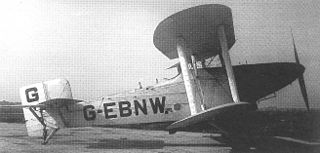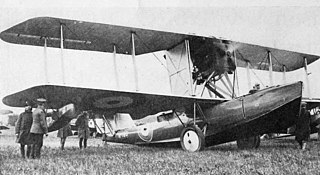
The Vickers Vernon was a British biplane troop carrier used by the Royal Air Force. It entered service in 1921 and was the first dedicated troop transport of the RAF.

The Curtiss F7C Seahawk was a carrier-capable biplane fighter aircraft of the United States Navy Marine Corps in the late 1920s and early 1930s.

The Mitsubishi B1M was a Japanese torpedo bomber of the 1920s, also known as the Navy Type 13 Carrier-Borne Attack Aircraft. It was designed and built by Mitsubishi and used in combat against China. The aircraft was used by the air services of the Imperial Japanese Navy and Imperial Japanese Army.

The Albatros L 65 was a German two-seat reconnaissance fighter biplane first flown in 1925.

The Westland Walrus was a British spotter/reconnaissance aircraft built by Westland Aircraft.

The Avro 566 Avenger was a prototype British fighter of the 1920s, designed and built by Avro. It was a single-seat, single-engine biplane of wood and fabric construction. Although it was a streamlined and advanced design, it never entered production.

The Airco DH.16 was a British four-seat commercial biplane of the 1910s designed by Geoffrey de Havilland, the chief designer at Airco.

The Avro 571 Buffalo was a prototype British carrier-based torpedo bomber biplane, designed and built by Avro in the 1920s. It was not selected for service, the Blackburn Ripon being ordered instead.

The Bristol Boarhound was a British army cooperation and liaison aircraft of the 1920s. It was a two-seat biplane with wings of equal span, of steel frame construction with fabric covering.

The Supermarine Sea Lion II was a British racing flying boat built by the Supermarine Aviation Works. Designed by Reginald Mitchell, it was a modification of Supermarine's Sea King II. Sea Lion II was powered by a 450 hp (340 kW) Napier Lion engine.

The Supermarine Sea King was a British single-seat amphibious biplane fighter designed by Supermarine in 1919. Developed from the Supermarine Baby and the Supermarine Sea Lion I, the Sea King was a single seater biplane powered by a pusher 160 horsepower (120 kW) Beardmore engine. It first flew in early 1920 and was exhibited by Supermarine at the 1920 Olympia Show in London. The company released drawings of the aircraft's design prior to the show; what it exhibited was probably a modified Supermarine Baby.

The Heinkel HD 17 was a military reconnaissance aircraft produced in Germany in the late 1920s.

The Handley Page Hanley was a British torpedo bomber aircraft of the 1920s. A single-engine, single-seat biplane intended to operate from the Royal Navy's aircraft carriers, it was not successful, with only three aircraft being built.

The Gloster Gorcock was a single-engined single-seat biplane fighter aircraft produced to a United Kingdom Air Ministry contract completed in 1927. Only three were built.

The Gloster Guan was a single-engined single-seat experimental biplane fighter built in the United Kingdom to test the performance of fighters using supercharged engines at high altitudes. Three were planned but only two constructed.
The Yokosuka E5Y was a single-engine Japanese seaplane used for reconnaissance. The E5Y was also built by Kawanishi as the E5K

The Supermarine Sheldrake was a British amphibian biplane flying boat developed by Supermarine from the Supermarine Seagull with a revised hull. It was powered by a Napier Lion engine mounted between the wings driving a four-bladed propeller. Only one Sheldrake, serial number N180, was built.

The Wibault 12 Sirocco or Wib 12 Sirocco was a two-seat, parasol wing fighter aircraft designed and built in France in the 1920s. Three fighter prototypes were completed, one for the RAF and two Army co-operation variants. There was no series production.
The Potez 26 was a single seat fighter aircraft designed and flown in France in the mid-1920s. It did not reach production.
The Caspar CJ 14 was a German fighter aircraft prototype built in the 1920s.

















